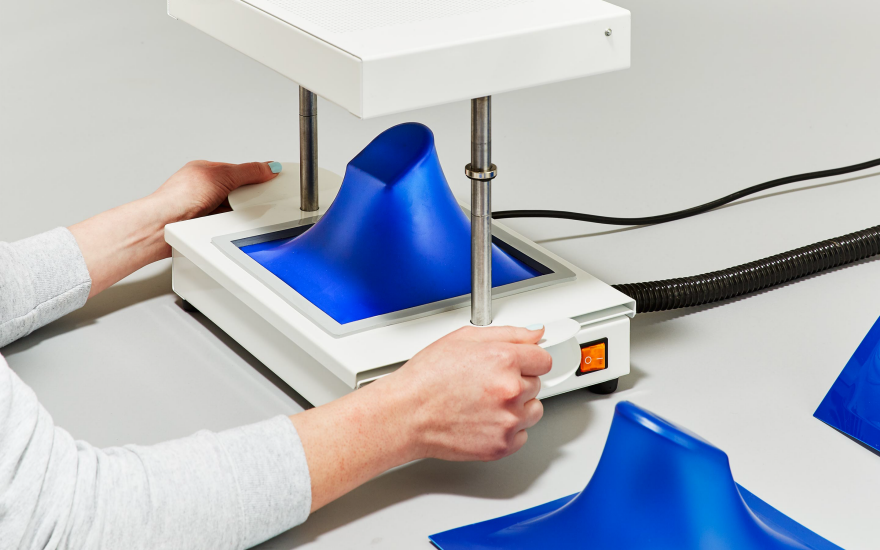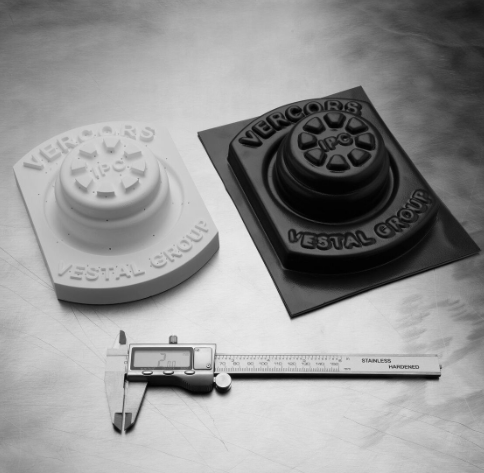Vacuum forming is advantageous due to its cost-efficiency, versatility in design, rapid prototyping capabilities, and excellent material utilization.

Fundamental Principles of Vacuum Forming
This process transforms a flat sheet of plastic into a three-dimensional shape through a combination of heat and pressure, with the vacuum ensuring the material conforms to the mold.
The Science Behind the Technique
To grasp the foundational science of vacuum forming, consider the following points:
- Heat Application: The plastic sheet must reach a specific temperature to become pliable.
- Material Expansion: When heated, the plastic expands.
- Vacuum Creation: A vacuum is applied to evacuate all air between the plastic sheet and the mold, creating atmospheric pressure that pushes the sheet into every contour of the mold. For a successful formation, a consistent vacuum pressure of approximately 14.7 psi (at sea level) is essential.
- Cooling Phase: Post-formation, the material must cool and solidify while still under vacuum. This phase can significantly impact the quality, with cooling times varying according to material thickness and type.
Key Components of a Vacuum Forming Machine
When considering the essential components of a vacuum forming machine, the following elements are critical for its operation:
- Heating Element: A high-quality vacuum forming machine typically employs ceramic heaters capable of rapidly reaching temperatures up to 250 degrees Celsius with precision control.
- Vacuum Pump: The vacuum pump is crucial, often requiring a flow rate of 3 to 5 cubic feet per minute (CFM) to effectively form the plastic sheet against the mold.
- Frame: A robust frame is necessary to hold the plastic sheet in place, with dimensions directly relating to the size of the product being formed. For example, a frame measuring 24 inches by 24 inches can accommodate materials for medium-sized products.
- Mold: Molds can vary in complexity and are often made from materials such as aluminum for its excellent heat transfer properties, facilitating faster cycle times. A mold’s lifespan can range significantly, with high-quality molds operating efficiently for tens of thousands of cycles.
- Control System: Modern vacuum forming machines integrate sophisticated control systems that allow for precise adjustments to variables like temperature and timing, vital for maintaining high standards of quality and efficiency.
Advantages of Vacuum Forming
Vacuum forming stands out as a preferred process in the manufacturing industry due to its distinct advantages ranging from cost-efficiency to environmental benefits.
Cost-Effectiveness and Economic Efficiency
Vacuum forming ranks as a highly economical process, especially when it comes to producing medium to large parts. Key cost advantages include:
- Lower Tooling Costs: The molds required for vacuum forming, compared to those used in processes like injection molding, are less expensive, often reducing initial project costs significantly. For example, a vacuum forming mold might cost anywhere from $2,000 to $5,000, whereas an injection mold can easily exceed $10,000 for the same part size and complexity.
- Energy Efficiency: It consumes less energy than other forming methods because it only needs to heat the plastic sheet, not the entire block of material. This can translate to energy savings of up to 50% compared to more intensive processes.
- Reduced Material Waste: The process generates less scrap material, with most vacuum forming operations reporting material utilization rates above 80%. This efficiency not only saves on material costs but also reduces the need for waste management.
Versatility in Material Selection
Vacuum forming supports a broad array of materials, providing manufacturers with the flexibility to choose based on the specific requirements of the product, such as impact resistance, clarity, or flexibility. Materials commonly used include:
- Acrylic (PMMA): Often used for transparent applications, offering clarity and resistance to UV light.
- Polystyrene (HIPS): Known for its ease of forming and post-processing, making it a go-to for many consumer products.
- ABS (Acrylonitrile Butadiene Styrene): Combines strength and rigidity, suitable for products requiring toughness.
Superior Aesthetic Outcomes
The aesthetic versatility of vacuum forming is substantial, allowing for:
- High-quality Finishes: Manufacturers can achieve a variety of textures and colors directly from the mold without the need for secondary processes.
Rapid Prototyping and Short Production Runs
Rapid prototyping is another area where vacuum forming shines:
- Speed: Prototypes can move from design to tangible part in a matter of days. Production cycles can be as short as 30 seconds for thin-gauge plastics, making it possible to produce hundreds of parts per hour depending on the complexity and material used.
- Adaptability: The process allows for quick adjustments to molds and designs, which is essential for iterative development processes.
Ease of Customization and Scalability
The customization potential in vacuum forming is vast due to:
- Flexible Mold Design: Adjusting molds to change sizes or features of the final product is generally straightforward and cost-effective.
- Scalability: Scaling production from a few prototypes to thousands of parts requires minimal additional investment in equipment and tooling.
Environmental Advantages of Vacuum Forming
Vacuum forming also offers benefits that contribute to sustainability:
- Recyclability: Many of the plastics used in vacuum forming, such as PETG, are fully recyclable, which helps in minimizing environmental impact.
- Reduction in Environmental Footprint: With lower energy requirements and material waste, vacuum forming presents a smaller environmental footprint compared to other forming methods.
Comparison with Other Forming Techniques
Understanding the differences between vacuum forming and other manufacturing processes is essential for selecting the most suitable method for a given application. This comparison focuses on key aspects such as cost, production speed, material usage, and design precision.
Vacuum Forming vs. Injection Molding
| Factor | Vacuum Forming | Injection Molding |
|---|---|---|
| Tooling Cost | ✔ Lower initial costs | ❌ Higher initial costs |
| Production Speed | ✔ Faster for prototypes and small runs | ✔/❌ Can be faster for large runs, slower startup |
| Material Versatility | ✔ Can use a wide range of materials | ✔ Can use a wide range of materials, including composites |
| Design Complexity | ❌ Less suited for complex designs | ✔ Ideal for complex designs and details |
| Part Strength | ❌ Generally less strength due to thinner walls | ✔ Parts are typically stronger |
| Waste Generation | ✔ Typically less waste | ❌ Can generate more waste due to runners, gates, etc. |
| Energy Consumption | ✔ Less energy-intensive | ❌ More energy-intensive |
For detailed insights on injection molding, the Wikipedia page on injection molding offers an extensive overview.
Vacuum Forming vs. Blow Molding
| Factor | Vacuum Forming | Blow Molding |
|---|---|---|
| Tooling Cost | ✔ Lower initial costs | ✔ Comparable but can vary based on complexity |
| Production Speed | ❌ Slower due to manual process stages | ✔ Generally faster due to automation |
| Material Versatility | ✔ Can use a wide range of sheet plastics | ❌ Typically limited to materials suitable for hollow parts |
| Design Complexity | ❌ Less suited for hollow or complex shapes | ✔ Specifically designed for hollow parts like bottles |
| Part Consistency | ✔ Consistent thickness in flat areas | ❌ Variable wall thickness can be an issue |
| Waste Generation | ✔ Less waste, as excess can be reused | ✔ Excess material can often be trimmed and recycled |
| Energy Consumption | ✔ Generally less energy consumption | ❌ Can be more energy-intensive |
Vacuum Forming vs. Thermoforming
| Factor | Vacuum Forming | Thermoforming |
|---|---|---|
| Tooling Cost | ✔ Lower cost for molds | ✔/❌ Costs can be higher depending on the technique |
| Production Speed | ✔ Suitable for quick turnarounds | ✔/❌ Varies, but some thermoforming methods are slower |
| Material Versatility | ✔ Broad material selection | ✔ Broad material selection |
| Design Complexity | ❌ Limited by single-sided molds | ✔ More design flexibility with detailed molds |
| Precision | ❌ Less precision compared to high-detail thermoforming | ✔ Higher precision with detailed molds |
| Waste Generation | ✔ Minimal waste | ✔/❌ Waste varies by process; some more than vacuum forming |
| Energy Consumption | ✔ Less energy required | ❌ Can be more energy-consuming |
Applications of Vacuum Forming
Each sector benefits from the unique attributes of vacuum forming, tailoring the process to meet specific requirements.
Use in Packaging Industry
The packaging sector relies heavily on vacuum forming for creating durable and visually appealing product packaging.
- Clamshell Packaging:The cost per unit for medium-sized clamshell packaging can be as low as a few cents when mass-produced.
- Trays and Blisters: Custom-designed trays and blister packs for items like electronics or pharmaceuticals are also vacuum-formed, offering protection and clear visibility. Production speed for these items can reach thousands of units per hour on more sophisticated machines.
- Cost Efficiency: The minimal waste and lower energy requirements of vacuum forming make it a cost-efficient option for the packaging industry, with energy costs notably less than those associated with other processes like injection molding.
Roles in Automotive Manufacturing
Vacuum forming contributes significantly to the automotive industry, particularly in creating large, sturdy, yet lightweight parts.
- Dashboards and Door Panels: Components such as dashboards, door panels, and other interior trim parts are commonly vacuum-formed, offering a balance between structural integrity and aesthetics.
- Air Ducts and Engine Covers: Functional parts like air ducts and engine covers benefit from the heat-resistant plastics that can be vacuum-formed.
- Material Quality and Speed: The quality of materials used in vacuum forming for automotive parts needs to withstand significant stress and temperature variations, which vacuum forming accommodates well.
Contributions to Medical Device Production
- Sterile Packaging: Vacuum-formed packaging is ideal for medical devices that require a sterile barrier, as it can be produced under cleanroom conditions.
- Medical Device Components: From housing for complex machinery to disposable trays for surgical instruments, the medical industry makes extensive use of vacuum-formed parts due to their precision and quality. For instance, components for medical devices must meet strict quality standards, often requiring tolerances within 0.1 millimeters.

Technical Innovations in Vacuum Forming
The field of vacuum forming has seen substantial advancements in materials, automation, and engineering, leading to greater capabilities and applications of the technology.
Advanced Materials in Vacuum Forming
Innovation in materials has expanded the capabilities and applications of vacuum forming.
- High-Performance Plastics: The use of high-performance plastics like polyetherimide (PEI) and polyetheretherketone (PEEK) in vacuum forming has allowed for the creation of parts that can withstand extreme temperatures and chemical exposure. These materials can significantly extend the lifespan of vacuum-formed components under harsh conditions.
- Sustainable Materials: These materials not only reduce environmental impact but also cater to the market’s growing eco-consciousness.
Automation and Control Systems
The integration of advanced automation and control systems has revolutionized the efficiency and precision of vacuum forming processes.
- Robotics: Incorporating robotics into vacuum forming lines has improved the consistency of production and reduced labor costs. Robotic arms can now manipulate the plastic sheets with precision, leading to a significant reduction in material wastage and operational expenses.
- Smart Control Systems: Modern vacuum forming machines are equipped with intelligent control systems that monitor and adjust process parameters in real time, ensuring optimal quality and reducing the margin for error. This level of control can increase production speeds by minimizing manual adjustments and downtime.
Custom Tooling and Precision Engineering
Custom tooling solutions and precision engineering have significantly increased the potential for creating intricate and accurate vacuum-formed components.
- 3D Printing for Tooling: The use of 3D printing technology to create custom tooling has reduced the cost and time involved in producing molds.
- Precision Machining: Advances in CNC machining have allowed for the creation of molds with very fine details and tight tolerances, essential for components that require a high degree of accuracy. This advancement has also opened up the possibility of vacuum forming for applications that were previously only achievable with more expensive processes like injection molding.




